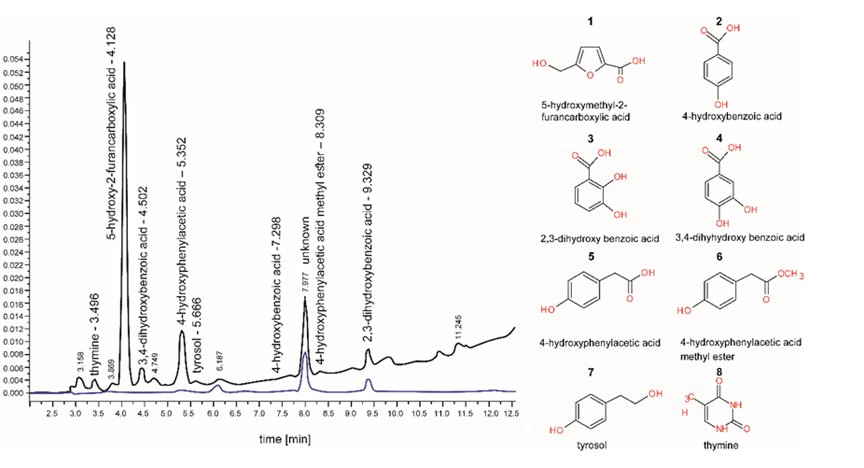Secondary metabolites of fungi and their biotechnological potential
Fungi are significant producers of natural chemicals, secondary metabolites, which has many applications in agriculture, medicine, and the food industry. These substances help fungi combat other organisms or mediate numerous interactions with the environment. In pathogenic species, they function as toxins involved in attacking host tissues. A single fungal species can produce dozens of compounds, and it is known that fungi, especially those not yet studied, harbor a great diversity of new secondary metabolites. In our projects, we identify natural compounds from poorly studied fungi (Chaetosphaeriales, Botryosphaeria, Geosmithia, Claviceps, Exobasidium, etc.). We test the activities of pure compounds across a broad spectrum of models to find treatments for infectious diseases, cancer, neurodegenerative, and parasitic diseases. This work involves extensive collaboration among institutes of the Czech Academy of Sciences within the AV21 Strategy project. The identified spectrum and biological activities further help us understand the taxonomy and ecological roles of their producers in ecosystems. For selected metabolites, we study the genetic background of production using genomics and molecular genetic methods. Key collaborators include the Department of Microbial Drugs, Helmholtz Centre for Infection Research, Braunschweig, Germany.

The main results are summarized in the following works.
- Stodůlková E, Man P, Kuzma M, Černý J, Císařová I, Kubátová A, Chudíčková M, Kolařík M, Flieger M, (2014). A highly diverse spectrum of naphthoquinone derivatives produced by the endophytic fungus Biatriospora sp. CCF 4378. Folia Microbiolica 60: 259-267.
- Stodůlková E, Císařová I, Kolařík M, Chudíčková M, Novák P, et al. (2015) Biologically active metabolites produced by the basidiomycete Quambalaria cyanescens. PLoS ONE 10(2): e0118913.
- van der Linde EJ, Pešicová K, Pažoutová S, Stodůlková E, Flieger M, Kolařík M (2016) Ergot species of the Claviceps purpurea group from South Africa. Fungal Biology 120: 917-30.
- Flieger M, Bandouchova H, Cerny J, Chudíčková M, Kolařík M, Kovacova V, Martínková N, Novák P, Šebesta O, Stodůlková E (2016) Vitamin B2 as a virulence factor in Pseudogymnoascus destructans skin infection. Scientific Reports 6: 33200.
- Flieger M, Stodůlková E, Wyka SA, Černý J, Grobárová V, Píchová K, Novák P, Man P, Kuzma M, Cvak L, Broders KM, Kolařík M (2019) Ergochromes: heretofore neglected dide of rrgot toxicity. Toxins 11: 439.
- Procházková E, Kucherak O, Stodůlková E, Tošner Z, Císařová I, Flieger M, Kolařík M, Baszczyňski O (2020) NMR structure elucidation of naphthoquinones from Quambalaria cyanescens. Journal of Natural Products 84: 46–55.
- Sklenář F, Jurjević Ž, Peterson SW, Kolařík M, Nováková A, Flieger M, Stodůlková E, Kubátová A, Hubka V (2020) Increasing the species diversity in the Aspergillus section Nidulantes: Six novel species mainly from the indoor environment. Mycologia 112: 342-370.
- Eliška Procházková, Oleksandr Kucherak, Eva Stodůlková, Zdeněk Tošner, Ivana Císařová, Miroslav Flieger, Miroslav Kolařík, and Ondřej Baszczyňski. Journal of Natural Products 2021 84: 46-55
- van der Linde EJ, Píchová K, Pažoutová S, Stodůlková E, Flieger M, Novák P, Kolařík M (2022) Pre-invasion assessment on African invasive grasses revealed five new species of ergot fungi, Claviceps section Pusillae. Fungal Biology 126:752-763.
- Štěpánek O, Čmoková A, Procházková E, Grobárová V, Černý J, Slapničková M, Zíková A, Kolařík M, O. Baszczyňski, (2022). Piperazine-modified ketoconazole derivatives show increased activity against fungal and trypanosomatid pathogens. ChemMedChem 2022, e202200385
- Charria-Girón E, Stchigel AM, Čmoková A, Kolařík M, Surup F, Marin-Felix Y. (2023) Amesia hispanica sp. nov., producer of the antifungal class of antibiotics dactylfungins. Journal of Fungi 9:463.
- Stadler M, Kolarik M (2024) Taxol is NOT produced sustainably by endophytic fungi!–A case study for the damage that scientific papermills can cause for the scientific communities. Fungal Biology Reviews 49:100367.
- Kolařík M, Stodůlková E, Kajzrová S, Semerád J, Hubert J, Kuzma M. et al (2024) Secondary metabolites and their impact on symbiotic interactions in the ambrosia fungus Geosmithia eupagioceri. bioRxiv 2024.07.15.603585.